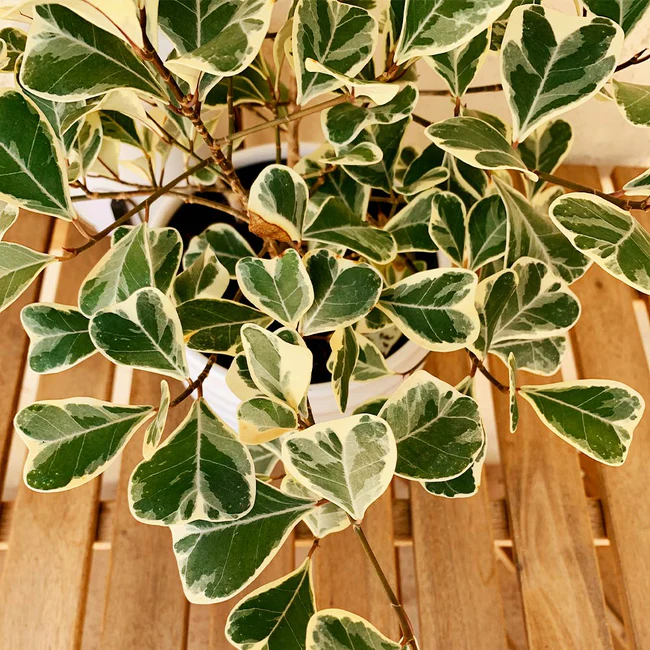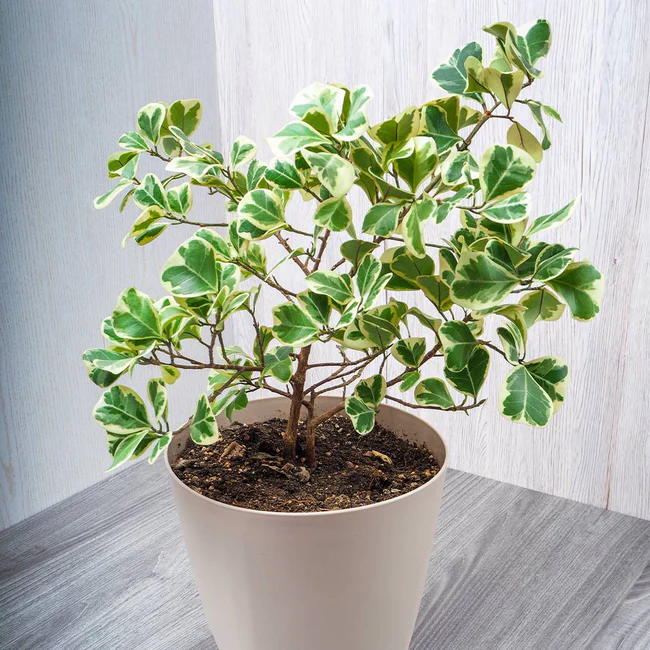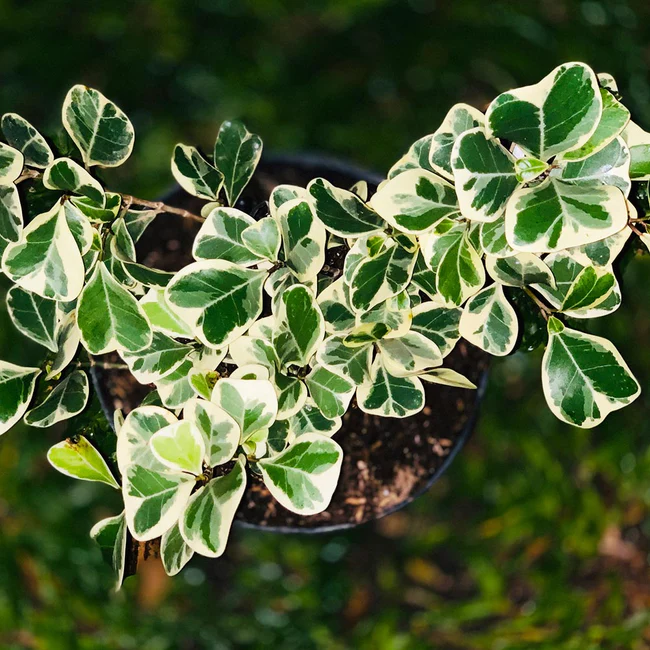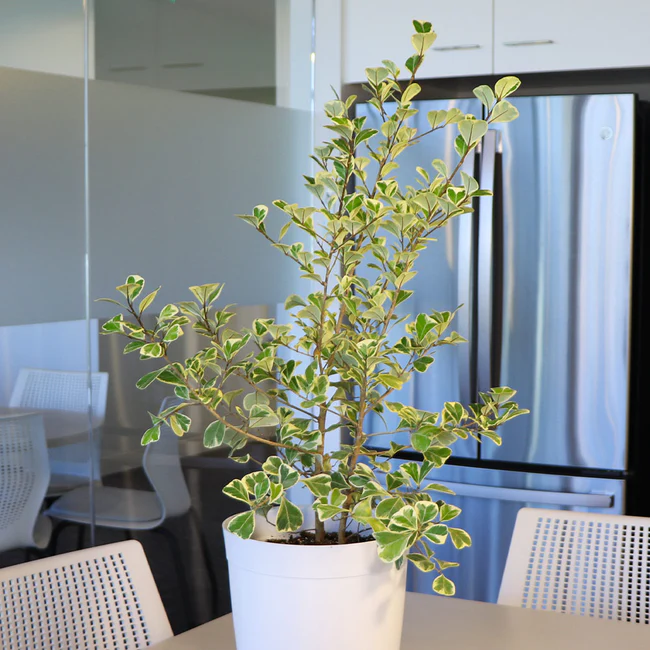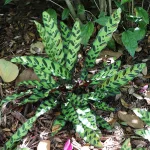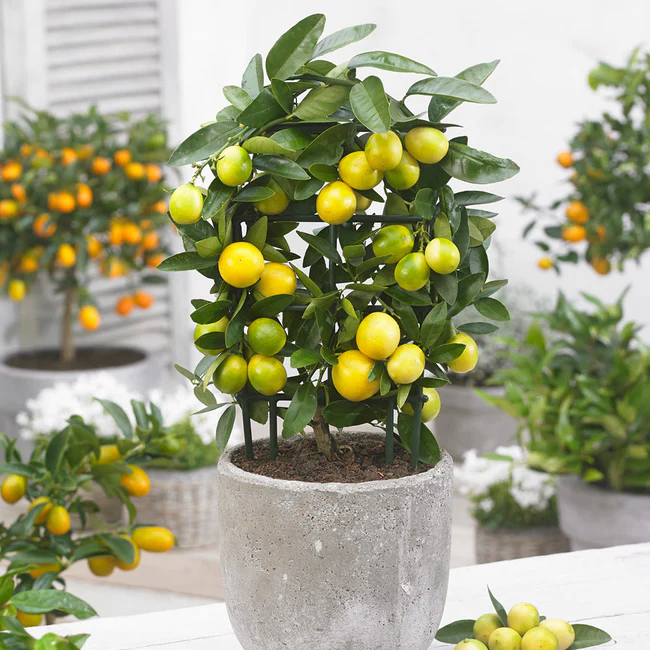This post contains affiliate links. If you buy something from one of our links we may earn a commission. Thanks
Triangle Ficus, also known as Ficus Triangularis Variegata, is an attractive and low-maintenance indoor plant that adds a touch of greenery to any room.
However, to keep your Triangle Ficus healthy and thriving, it’s important to provide proper care.
Triangle Ficus care involves providing well-draining soil, bright, indirect sunlight, and keeping the soil moist but not waterlogged. It’s advisable to allow the top of the soil to dry between waterings, and feed with a balanced fertilizer during the growing season for optimal growth and health.
Triangle Ficus with its variegated triangular leaves is an extremely attractive houseplant.
Providing proper care for your Triangle Ficus is essential for maintaining its health and longevity.
From lighting and watering to pests and diseases, we’ll cover everything you need to know to keep your Triangle Ficus lush and vibrant.
In this article, we’ll uncover the 7 secrets to successful Triangle Ficus care, so that you can enjoy a lush, healthy plant for years to come.
So, if you’re ready to bring your indoor jungle to the next level, let’s get started!
You can buy your Tringle Ficus right here.
The Importance of Triangle Ficus Care
Why proper care is essential:
Triangle Ficus plants are delicate and require specific conditions to thrive. It is a tropical plant that likes warm temperatures.
Proper care ensures that your plant has the right environment, nutrition, and hydration to grow and stay healthy.
Without proper care, your Triangle Ficus may become susceptible to pests, diseases, or environmental stress, leading to a decline in health and potential death.
Benefits of healthy Ficus triangularis plants:
A well-cared-for Triangle Ficus will have lush, green leaves and a strong, sturdy stem.
A healthy plant will also be better equipped to resist pests and diseases, making it a more attractive and low-maintenance addition to your home.
Consequences of poor care:
Neglecting the care of your Triangle Ficus can lead to yellowing leaves, stunted growth, and leaf drop.
In severe cases, it may also become more susceptible to pests and diseases, which can cause serious harm and even death to your plant.
It is essential to provide proper care to ensure that your Triangle Ficus remains healthy and vibrant.
7 Triangle Ficus Care Secrets for a Lush, Healthy Plant
Whether you’re a seasoned plant parent or a newcomer to the world of indoor gardening, this guide to Triangle Ficus Care will provide you with the secrets to success.
Secret 1: Proper Lighting
A proper lighting environment is critical to the health and growth of your Triangle Fig.
In this section, we will explore the importance of providing the right amount of light for your ficus tree, including its specific lighting needs and how to tell if the lighting conditions are right.
With the right light, your Triangle Ficus will thrive and bring a touch of green to your home for years to come.
Triangle Ficus lighting needs:
Triangle Ficus plants require bright light to grow and thrive. Although they do require bright light they do not tolerate direct sunlight, which can scorch their delicate leaves and cause leaf drop.
Best lighting conditions:
The ideal lighting conditions for Triangle Ficus are a bright, sunny spot away from direct sunlight.
This can be achieved by placing the plant near a window with sheer curtains, or by providing it with artificial light.
How to tell if the lighting is wrong:
If your Triangle Ficus is not getting enough light, its leaves may become pale and yellow.
If it is getting too much light, its leaves may become scorched or discolored.
To ensure that your plant is getting the right amount of light, keep an eye on its leaves and make adjustments as needed.
Secret 2: Watering
Watering is a crucial component of Triangle Ficus care, and it’s important to get it right.
Overwatering or underwatering can both lead to serious problems for your plant.
In this section, we’ll cover the specifics of watering your Triangle Ficus, including the best frequency and amount, as well as how to tell if your plant is getting the right amount of water.
By following these tips, you’ll be able to keep your Triangle Ficus healthy and hydrated.
Triangle Ficus watering needs:
Triangle Ficus plants prefer to have moist soil, but they don’t tolerate being in standing water. Overwatering can lead to root rot, which can be fatal to your plant.
Make sure you use a pot with drainage holes. You can also place a thin layer of gravel in the bottom of the pot to help with drainage.
How often to water:
The frequency of watering will depend on factors such as the size of your plant, the temperature, and the humidity in your home.
As a general rule, you should water your Triangle Ficus when the top inch of soil feels dry. A good way to test the soil moisture is by sticking your finger into the soil.
Signs of over- and under-watering:
Overwatering can cause yellowing leaves and mushy, foul-smelling soil. On the other hand, underwatering can cause the leaves to drop and the stem to become limp.
By keeping an eye on the leaves and the soil moisture, you can ensure that your Triangle Ficus is getting the right amount of water.
Secret 3: Humidity
Humidity levels play an important role in the health of your Triangle Ficus.
With the right humidity conditions your plant will grow strong and vibrant, but with too little or too much humidity, it can suffer from issues like dry leaves and yellow leaves.
In this section, we’ll explore the ideal humidity levels for Triangle Ficus, how to tell if the humidity levels in your home are right, and how to adjust them if necessary.
By providing the right humidity, you’ll help ensure that your Triangle Ficus stays healthy and lush.
Triangle Ficus humidity needs:
Triangle Ficus plants prefer moderately humid conditions with a level of humidity, between 40-60%.
This is because they originate from tropical regions with a consistent, moist environment.
How to maintain proper humidity levels:
There are several ways to maintain proper humidity levels for your Triangle Ficus, such as using a small humidifier, misting the leaves, or pebble tray, or placing a tray of water near the plant.
You can also use a hygrometer to measure the humidity levels in your home.
Signs of high or low humidity levels:
If the humidity levels are too high, you may notice mold growth on the soil or yellowing leaves.
If the humidity levels are too low, you may notice dry leaves or leaf tips.
By keeping an eye on the plant and monitoring the humidity levels, you can help ensure that your Triangle Ficus stays healthy.
Secret 4: Fertilization
Fertilization is an important aspect of Triangle Ficus care, as it provides the necessary nutrients to help your plant grow strong and healthy.
However, it’s important not to over-fertilize, as this can lead to nutrient burn or other problems.
In this section, we’ll explore the right fertilizer to use, how often to fertilize, and how to avoid over-fertilization.
Triangle Ficus fertilization needs:
Triangle Ficus plants require a balanced, slow-release fertilizer to provide them with the necessary nutrients for growth.
When to fertilize:
Triangle Ficus should be fertilized once a month during the summer season, which is typically spring through fall.
In the winter months, when the plant is dormant, it is best to skip fertilization.
How to choose the right fertilizer:
Look for a balanced, slow-release fertilizer specifically designed for houseplants.
Avoid using a fertilizer with high nitrogen content, as this can lead to leggy growth and other problems.
By choosing the right fertilizer and fertilizing at the right time, you’ll help ensure that your Triangle Ficus stays healthy and lush.
The use of tree spikes will take the guesswork out of fertilizing. Here is what I recommend for  fertilizing your triangle ficus.
fertilizing your triangle ficus.
I recommend using Jobes Organics fertilizer spikes.
They are easy to use and last for 2-3 months.
They are designed for container-grown citrus but with a 3-5-5 formulation they work well for ficus trees too.
Using 2 spikes for a 12-inch pot or 3 for an 18-inch pot takes the guesswork out of fertilizing.
VI. Secret 5: Soil
The soil you use for your Triangle Ficus is important for the health of your plant.
The right soil should provide good drainage, yet retain enough moisture to keep the roots hydrated.
In this section, we’ll explore what type of soil is best for your Triangle Ficus, how to prepare the soil, and how to make sure the soil remains healthy.
By following these tips, you’ll help ensure that your Triangle Ficus thrives.
Triangle Ficus soil needs:
Triangle Ficus plants prefer well-draining soil with a slightly acidic pH that retains moisture without becoming waterlogged.
Best soil type and composition:
A mixture of peat moss, perlite, and sand works well for Triangle Ficus. You can also use a pre-made potting mix specifically designed for houseplants.
I prefer using coco coir and perlite for all my plants because it is more environmentally friendly than peat-based products.
Signs of improper soil:
If the soil is too waterlogged, the roots of the plant may become waterlogged and rot.
On the other hand, if the soil is too dry, the plant may become wilted and dry out. Additionally, if the soil pH is too alkaline, it can lead to yellowing leaves and stunted growth.
By making sure to use fertile soil that is the right type and composition, you’ll help ensure that your Triangle Ficus stays healthy and lush.
Secret 6: Pruning
Pruning is an important aspect of Triangle Ficus care that can help keep your plant healthy and looking its best.
In this section, we’ll cover why pruning is important, when is the best time to prune, and how to do it properly.
Triangle Ficus pruning needs:
Pruning helps to remove dead, damaged, or diseased growth and encourages bushier growth and helps to keep the plant’s shape.
When to prune:
The best time to prune is during the growing season, typically in spring or summer.
How to prune correctly:
Use clean, sharp pruning shears to make a clean cut just above a node (where a leaf or branch meets the stem).
Avoid cutting too much at once and removing more than one-third of the plant’s growth.
With regular pruning, you’ll help your Triangle Ficus plant maintain its shape and promote healthy growth.
Secret 7: Pests and Diseases
Pests and diseases can quickly ruin a beautiful and healthy Triangle Ficus plant if not addressed promptly.
In this section, we’ll discuss the most common pests and diseases, how to spot them, and how to prevent and treat them.
By being proactive and vigilant, you can keep your Triangle Ficus free of pests and diseases and maintain its lush, healthy appearance.
Common pests and diseases affecting Triangle Ficus:
Common pests that affect Triangle Ficus include spider mites, mealybugs, and scale insects. Common diseases include root rot, leaf spot, and powdery mildew.
How to prevent and treat infestations and diseases:
Prevention is key, so keep the plant clean and free of debris, and avoid overwatering.
If you notice an infestation or disease, use a non-toxic pesticide or fungicide to treat it as soon as possible.
Signs of a healthy plant:
A healthy Triangle Ficus should have bright green leaves, free of yellowing or brown spots.
It should also have a sturdy stem and be free of any visible pests or diseases.
By monitoring the appearance of your Triangle Ficus, you can quickly spot any issues and take steps to address them before they become more serious.
Secret 8: Propagation
Propagating your Triangle Ficus plant is a great way to ensure its continued growth and health.
Whether you’re looking to create more plants or simply keep your current one thriving, learning the basics of Triangle Ficus propagation is a must.
In this section, we’ll cover all the important details to help you successfully propagate your Triangle Ficus and enjoy a lush, healthy plant for years to come.
Triangle Ficus Propagation
Propagation is the process of creating new plants from existing ones.
In the case of the Triangle Ficus, it can be propagated through cuttings, division, or layering.
Propagation allows you to increase the number of plants you have and also helps keep your existing Triangle Ficus healthy by removing any overgrown or leggy sections.
Methods of Propagation:
Cuttings: Taking cuttings from your Triangle Ficus is a quick and easy way to propagate new plants.
Simply cut a healthy stem from the parent plant and place it in water or moist soil to root.
Division: If your Triangle Ficus has become root-bound, you can propagate new plants by dividing the root system.
Remove the plant from its pot and gently separate the roots into several sections.
Layering: Another method of Triangle Ficus propagation is layering. This involves rooting a stem while it is still attached to the parent plant. Simply bend a stem down to the soil, cover it with soil, and keep it moist until roots have form
Tips for Successful Propagation
• Use healthy, pest-free cuttings
• Maintain the right temperature and humidity levels
• Keep the soil or rooting medium moist but not waterlogged
• Provide adequate light for the new plant to thrive.
Secret 9: Ficus Triangularis Dropping Leaves
Triangle Ficus, also known as a Ficus Triangularis, is a popular houseplant known for its beautiful foliage and ease of care.
However, common problems for Triangle Ficus plants are the shedding of their triangular-shaped leaves, which can be a sign of stress or poor care.
We’ll explore the common causes of Triangle Ficus dropping leaves and what you can do to prevent it.
Triangle Ficus is a popular indoor plant that adds greenery to any space. However, one common issue that Ficus owners face is the sudden drop of leaves.
This can be a frustrating problem as it can compromise the plant’s health and appearance.
In this section, we’ll dive into the reasons behind Ficus dropping leaves and how to prevent it from happening.
What factors cause dropping leaves?
Dropping leaves in a Ficus triangularis plant can be caused by several factors, including:
• Improper lighting – not enough light or too much direct sunlight can stress the plant and cause it to drop leaves.
• Inconsistent watering – either over- or under-watering the plant can cause leaves to fall off.
• Low humidity – Ficus triangularis plants prefer relatively high humidity, and low humidity levels can cause leaf drop.
• Poor soil conditions – soil that is too wet or too dry, or lacks proper nutrients, can cause leaves to fall off.
• Pests or diseases – infestations or illnesses can weaken the plant and cause leaves to drop.
• Rapid changes in the environment – moving the plant to a new location or sudden changes in temperature or light can cause stress and lead to leaf drop.
• Sudden changes in room temperature or humidity or cold drafts from an air conditioner can cause leaf drop
• Natural process – some leaf drop is normal as the plant grows and sheds older leaves to make room for new growth.
Triangle Ficus FAQs
The Triangle Ficus, known for its unique leaf shape and easy care, attracts many enthusiasts. However, like any plant, it has its own set of requirements and common issues.
Through the questions and answers below, we aim to address some of the most frequently asked questions about Triangle Ficus care, aiding you in nurturing a healthy, thriving plant.
Q. How often should I water my Triangle Ficus?
A. Watering should be done when the top inch of soil feels dry to the touch. Over-watering can lead to root rot, so it’s important to allow the soil to dry slightly between waterings.
Q. What type of light does a Triangle Ficus require?
A. Triangle Ficus thrives in bright, indirect light, although it can tolerate lower light levels. Too much direct sunlight can cause leaf scorch.
Q. How should I fertilize my Triangle Ficus?
A. During the growing season, typically spring and summer, feed your Triangle Ficus with a balanced fertilizer every 4 to 6 weeks. In fall and winter, the plant requires no fertilizer.
Q. What are common pests and diseases that affect Triangle Ficus?
A. Common pests include spider mites, aphids, and mealybugs. Regularly cleaning the leaves and keeping the plant in good health can help prevent infestations. Fungal diseases can occur with over-watering, so it’s crucial to keep the soil well-draining and not waterlogged.
Final Thoughts
Recap of the 7 Triangle Ficus care secrets:
Proper lighting, watering, humidity, fertilization, soil, pruning, and pest and disease management are all important aspects of Triangle Ficus care.
Triangle Ficus plants are beautiful, versatile, and low-maintenance, making them a great addition to any home or office.
By following the secrets outlined in this post, you can help keep your Triangle Ficus healthy and thriving, adding a touch of natural beauty to your space.
If you’re ready to take your Triangle Ficus care to the next level, put these secrets into practice today!
Whether you’re a seasoned plant parent or a beginner, these tips will help you get the most out of your Triangle Ficus, and enjoy a lush, healthy plant for years to come.
Get your Ficus Triangularis here
Discover the 20 Benefits Of Keeping Indoor Plants For Improved Lifestyle

